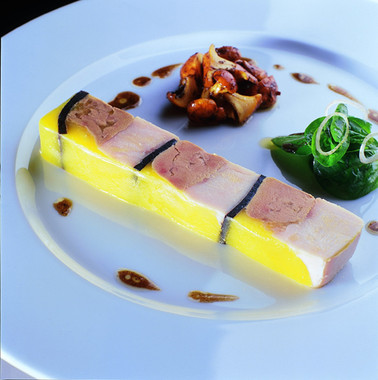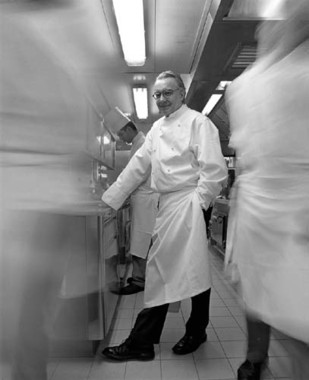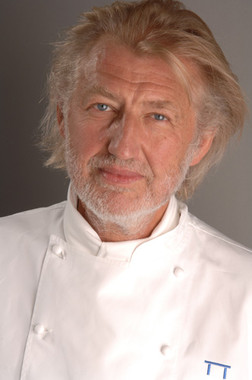The Centurion Menu - Pierre Gagnaire & Alain Ducasse
April 2008 - Centurion Magazine - Australia

PARIS – How to choose? Hepburn or Monroe? Porsche or Ferrari? Here in the City of Light, lucky diners can select between Alain Ducasse and Pierre Gagnaire for two completely different versions of the meal of a lifetime. Normally, the choice would be a tricky one, a matter of mood and taste, but this time it’s easy; the two legendary chefs have collaborated to create one mouthwatering menu exclusively for Centurion Magazine.
The pair have opted for three emblematic and truly French products, chosen, as Gagnaire says, “to create a single themeâ€. For their collaboration, Ducasse had the honour of selecting the products at the heart of the menu: appetizers with truffles (bien sûr!), main courses using vin jaune – a dry ‘yellow wine’ from the Jura made from savagnin grapes – and desserts featuring quince.
The combined résumé for the two chefs reads like a laundry list of some of the best restaurants around the world. Gagnaire, based in Paris where he runs his eponymous Michelin three-star restaurant at the Hôtel Balzac and the fish-centric Gaya, also runs high-end restaurants in London, Hong Kong and Tokyo. Most recently, he opened the Hôtel de Charme les Airelles in Courchevel, France and the Reflets par Pierre Gagnaire in Dubai.
Along with what he calls his high-end ‘signature’ restaurants in Paris, Monaco and Tokyo, Alain Ducasse runs other restaurants in Hong Kong, Mauritius, Saint Tropez, New York and Las Vegas. Add to this the November 2007 opening of Alain Ducasse at the Dorchester in
London and the January opening of Adour in the St Regis hotel in New York, and the total is well over twenty. Perhaps the most interesting news, however, was the January reopening of Le Jules Verne in the Eiffel Tower, now under the auspices of Ducasse and his team.
When discussing this menu, Ducasse plunges directly into his produce choices and in the end, it’s the people who supply his produce that he counts on the most. “A great product is never something from an industrial group. It’s the work of individuals,†he says. “Without them as a base, you can’t do anything.“
 “Without [great produce] you can’t do anything,” says Alain Ducasse. (Photo: courtesy Bureau Alain Ducasse - (c) Benoit Peverelli, photographer).
“Without [great produce] you can’t do anything,” says Alain Ducasse. (Photo: courtesy Bureau Alain Ducasse - (c) Benoit Peverelli, photographer).“You might find truffles elsewhere in the world,“ he adds, returning to his home country, “but they are perfectly integrated in the spirit of French cuisine.â€
Looking like a brightly-coloured ingot, his Bresse chicken with black truffle and foie gras jelly is a modern combination of three classic French ingredients. “Vin jaune is uncommon,†he says, referring to the wine’s intense aromas that can range from minerals to nuts and honey. “It’s something very specific and very French. It makes a unique sauce that reduces very well and you can add a little bit more at the end to make it shine.â€
“Quince has a very particular flavour and I love the unique taste, but you’ve got to give it a ‘boost’,“ he adds, borrowing the last word from English. “There are fruits and vegetables which don’t have ‘talent’ on their own, but it’s a great accessory.†His boost comes in a tart with grapefruit and a caramel tea cream.
Speaking with both chefs, I get the sense that whether they are in Paris, Hong Kong, the US or elsewhere, Ducasse and Gagnaire are ambassadors for French cuisine, yet Ducasse always defers to the product. Were they to make the menu on another continent, the dishes would be completely different. “First, we look to see what’s around us,†says Ducasse. “We try to import as little as possible. In the US we import nothing. The sea bass (thought of here as a French staple) are caught on long lines off of New York.â€
“The French system is more based on the savoir faire of how to deal with flavour,†he says, making a direct reference to the French flair for sauces and an indirect one to his poached, roasted red emperor (a white-fleshed snapper found primarily near Australia), mashed and crispy black Congo potatoes and vin jaune sauce. “With a code and a feeling, there’s alchemy.â€
Then Ducasse spices things up a little: “Italian food has a more specific taste,“ he says, grinning with the knowledge that the comment would raise the hackles of his French colleagues if he didn‘t explain. “The real ‘French touch,’†he adds proudly, “is method, professionalism, rigour and organisation.â€
For Gagnaire’s part in the diplomatic process, he uses a similar alchemy to remind the French (and the rest of the world) what makes their cuisine great. “We’re in a country that’s wondering about itself,†he says, referencing everything from politics and social issues to food and wine. “I want to show that we still know how to do it.â€
 A mix of haddock, artichoke, truffles and celery root? “Why not?” replies chef Pierre Gagnaire, “It’s not logic, it’s my personal taste,” (Photo courtesy Agence 14 Septembre - (c)Jacques Gavard, photographer)
A mix of haddock, artichoke, truffles and celery root? “Why not?” replies chef Pierre Gagnaire, “It’s not logic, it’s my personal taste,” (Photo courtesy Agence 14 Septembre - (c)Jacques Gavard, photographer)His secret to rejuvenating l’art de vivre? Do what you love. “Do it honestly and with energy,†he says. Wherever he is or whatever he’s working with, Gagnaire has a clear vision of how this should come together. “My style is joyous, immediate and tries to tell a story. I want to make people dream and bring them somewhere they don’t know.â€
This becomes clear even before the Centurion menu is set and Gagnaire begins brainstorming for his recipes, reeling off some of his favourite products like oysters, game and cauliflower with a childlike enthusiasm. It almost seems like he pulls certain combinations out of thin air, but listening to him, he’s clearly reaching into his soul. I ask about the combination of haddock and truffles, artichoke and celery root that he’s proposed and he replies with a quick “Why not? It’s not logic. It’s my personal taste.â€
Perhaps the most interesting and challenging part of the story Gagnaire is trying to tell with the Centurion menu is what he calls his “Liebigâ€. Named after a 19th century German scientist, a Liebig is one of the fruits of Gagnaire‘s monthly collaboration with French molecular gastronomist Hervé This, who describes it as a “physically gelled emulsion†based on nothing but oil, water and gelatin.
“The taste?†asks This on Gagnaire‘s website, “It‘s clearly pathetic if it‘s just water and a neutral oil, but if the ‘water’ is a lobster bisque, and the oil an olive oil marinated with ginger and orange? Mmm! That could be good.†Inspired by his friend, Gagnaire proposes a Liebig made with vin jaune served with grilled scallops, salsify and Jerusalem artichokes. Mmm, indeed.
“People like Ducasse and me, it’s up to us to show these good things,†concludes Gagnaire. It seems to be working. “In Asia, they are very interested in l’art de vivre. Particularly the French style.†I swear that even over the phone, I could hear him crack a smile.
-fin-
See the .pdf version of this story - with recipes - as it ran in Centurion Magazine here